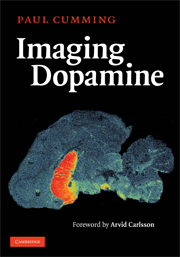Book contents
- Frontmatter
- Contents
- Foreword
- Acknowledgments
- Introduction
- 1 The life history of dopamine
- 2 Enzymology of tyrosine hydroxylase
- 3 The assay of tyrosine hydroxylase
- 4 Enzymology of aromatic amino acid decarboxylase
- 5 PET studies of DOPA utilization
- 6 Conjugation and sulfonation of dopamine and its metabolites
- 7 Dopamine synthesis and metabolism rates
- 8 MAO activity in the brain
- 9 Vesicular storage of dopamine
- 10 Dopamine release: from vesicles to behavior
- 11 The plasma membrane dopamine transporter
- 12 Dopamine receptors
- 13 Imaging dopamine D1 receptors
- 14 Imaging dopamine D2 receptors
- 15 Factors influencing D2 binding in living brain
- 16 The absolute abundance of dopamine receptors in the brain
- 17 Conclusions and perspectives
- References
- Index
- Plate section
Foreword
Published online by Cambridge University Press: 04 December 2009
- Frontmatter
- Contents
- Foreword
- Acknowledgments
- Introduction
- 1 The life history of dopamine
- 2 Enzymology of tyrosine hydroxylase
- 3 The assay of tyrosine hydroxylase
- 4 Enzymology of aromatic amino acid decarboxylase
- 5 PET studies of DOPA utilization
- 6 Conjugation and sulfonation of dopamine and its metabolites
- 7 Dopamine synthesis and metabolism rates
- 8 MAO activity in the brain
- 9 Vesicular storage of dopamine
- 10 Dopamine release: from vesicles to behavior
- 11 The plasma membrane dopamine transporter
- 12 Dopamine receptors
- 13 Imaging dopamine D1 receptors
- 14 Imaging dopamine D2 receptors
- 15 Factors influencing D2 binding in living brain
- 16 The absolute abundance of dopamine receptors in the brain
- 17 Conclusions and perspectives
- References
- Index
- Plate section
Summary
This book is timely and will prove useful for many researchers interested not only in the specific topic, “Imaging Dopamine,” but also in more general aspects of dopamine. In neurotransmitter research, dopamine has served a spearhead function ever since its discovery in the brain half a century ago. Dopamine has also played a key role in molecular imaging research; the imaging of dopamine receptors started very early in the history of positron emission tomography.
Although this book has its focus on imaging, the full utilization of imaging techniques depends on the background knowledge gained from other methodologies, a theme that has been duly considered by the author. Thus, the various aspects of dopamine, dealing, for example, with its synthesis, storage, release, and metabolism, as well as with the enzymes and transporter proteins involved in these processes, are treated in sufficient detail to provide a well-integrated and reasonably complete picture of the very complex dopamine transmission machinery.
It should go without saying that the growth of knowledge regarding the various aspects of neurotransmission has not taken place without intervals of considerable disagreement and controversy. In the course of the past half century's intense research, many issues have been resolved, whereas others are still being debated. I am pleased to find that the author has devoted some space to historical aspects, starting out with a scheme of the dopamine nerve terminal published by me in 1966.
- Type
- Chapter
- Information
- Imaging Dopamine , pp. xiii - xivPublisher: Cambridge University PressPrint publication year: 2009

